FNN 6800: Financial Performance Management Report Analysis
VerifiedAdded on 2023/01/04
|11
|3284
|44
Report
AI Summary
This report provides a comprehensive analysis of financial performance management, focusing on environmental cost accounting and the application of management accounting planning tools. Part 1 delves into the challenges businesses face in managing environmental costs, exploring various methods used for accounting, including prevention, appraisal, internal and external failure costs, and the importance of cost-benefit analysis. It examines techniques like input/outflow analysis, activity-based costing, and life-cycle costing. Part 2 critically analyzes how businesses incorporate management accounting planning tools such as zero-based budgeting, capital budgeting, and activity-based budgeting to address financial problems and achieve financial sustainability, with a particular emphasis on the relevance of budgetary control. The report highlights the significance of decision-making, information gathering, and the role of planning tools in resolving financial issues and improving overall performance. The report concludes by emphasizing the importance of both environmental cost management and effective planning tools in ensuring long-term financial health and sustainability.
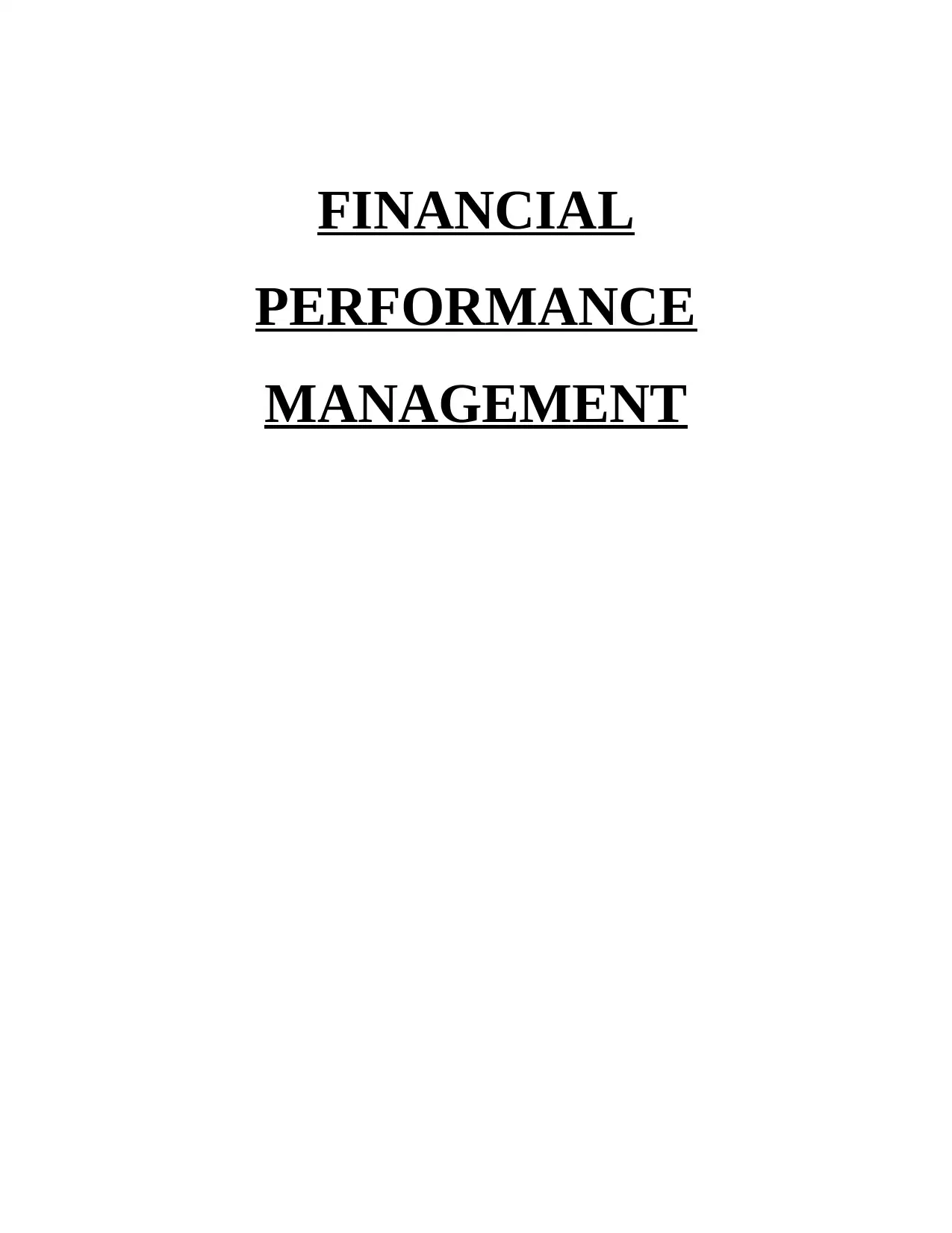
FINANCIAL
PERFORMANCE
MANAGEMENT
PERFORMANCE
MANAGEMENT
Paraphrase This Document
Need a fresh take? Get an instant paraphrase of this document with our AI Paraphraser
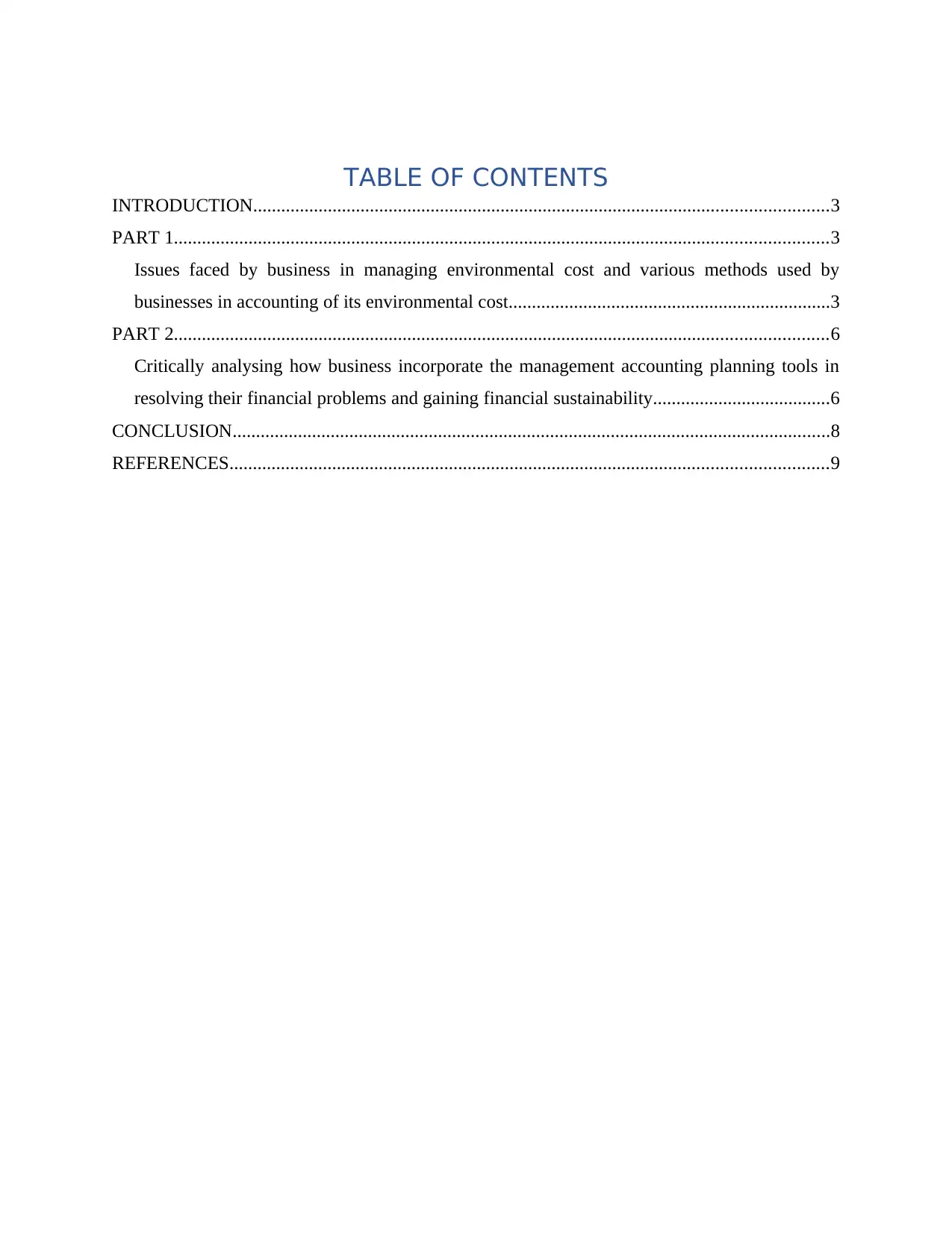
TABLE OF CONTENTS
INTRODUCTION...........................................................................................................................3
PART 1............................................................................................................................................3
Issues faced by business in managing environmental cost and various methods used by
businesses in accounting of its environmental cost.....................................................................3
PART 2............................................................................................................................................6
Critically analysing how business incorporate the management accounting planning tools in
resolving their financial problems and gaining financial sustainability......................................6
CONCLUSION................................................................................................................................8
REFERENCES................................................................................................................................9
INTRODUCTION...........................................................................................................................3
PART 1............................................................................................................................................3
Issues faced by business in managing environmental cost and various methods used by
businesses in accounting of its environmental cost.....................................................................3
PART 2............................................................................................................................................6
Critically analysing how business incorporate the management accounting planning tools in
resolving their financial problems and gaining financial sustainability......................................6
CONCLUSION................................................................................................................................8
REFERENCES................................................................................................................................9
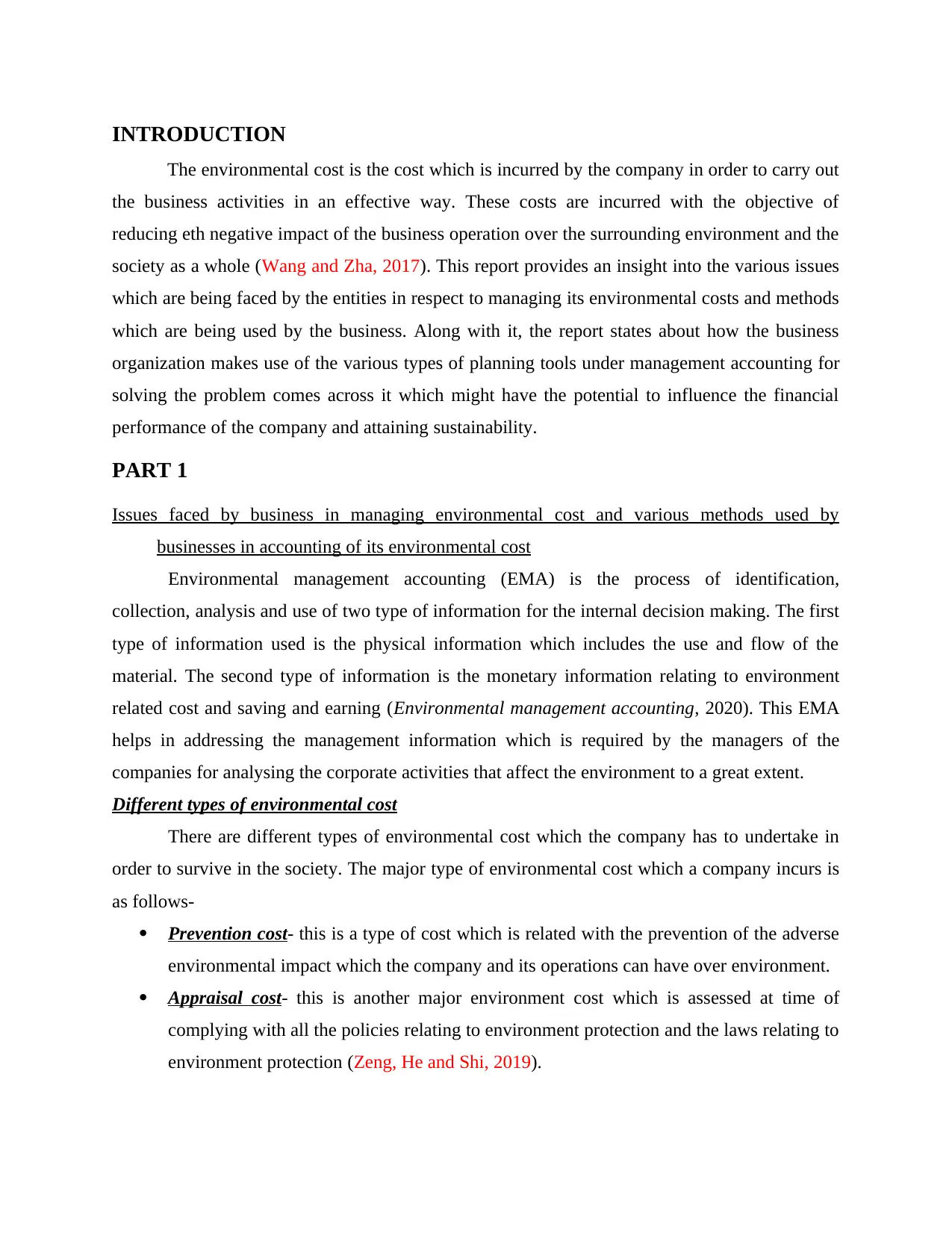
INTRODUCTION
The environmental cost is the cost which is incurred by the company in order to carry out
the business activities in an effective way. These costs are incurred with the objective of
reducing eth negative impact of the business operation over the surrounding environment and the
society as a whole (Wang and Zha, 2017). This report provides an insight into the various issues
which are being faced by the entities in respect to managing its environmental costs and methods
which are being used by the business. Along with it, the report states about how the business
organization makes use of the various types of planning tools under management accounting for
solving the problem comes across it which might have the potential to influence the financial
performance of the company and attaining sustainability.
PART 1
Issues faced by business in managing environmental cost and various methods used by
businesses in accounting of its environmental cost
Environmental management accounting (EMA) is the process of identification,
collection, analysis and use of two type of information for the internal decision making. The first
type of information used is the physical information which includes the use and flow of the
material. The second type of information is the monetary information relating to environment
related cost and saving and earning (Environmental management accounting, 2020). This EMA
helps in addressing the management information which is required by the managers of the
companies for analysing the corporate activities that affect the environment to a great extent.
Different types of environmental cost
There are different types of environmental cost which the company has to undertake in
order to survive in the society. The major type of environmental cost which a company incurs is
as follows-
Prevention cost- this is a type of cost which is related with the prevention of the adverse
environmental impact which the company and its operations can have over environment.
Appraisal cost- this is another major environment cost which is assessed at time of
complying with all the policies relating to environment protection and the laws relating to
environment protection (Zeng, He and Shi, 2019).
The environmental cost is the cost which is incurred by the company in order to carry out
the business activities in an effective way. These costs are incurred with the objective of
reducing eth negative impact of the business operation over the surrounding environment and the
society as a whole (Wang and Zha, 2017). This report provides an insight into the various issues
which are being faced by the entities in respect to managing its environmental costs and methods
which are being used by the business. Along with it, the report states about how the business
organization makes use of the various types of planning tools under management accounting for
solving the problem comes across it which might have the potential to influence the financial
performance of the company and attaining sustainability.
PART 1
Issues faced by business in managing environmental cost and various methods used by
businesses in accounting of its environmental cost
Environmental management accounting (EMA) is the process of identification,
collection, analysis and use of two type of information for the internal decision making. The first
type of information used is the physical information which includes the use and flow of the
material. The second type of information is the monetary information relating to environment
related cost and saving and earning (Environmental management accounting, 2020). This EMA
helps in addressing the management information which is required by the managers of the
companies for analysing the corporate activities that affect the environment to a great extent.
Different types of environmental cost
There are different types of environmental cost which the company has to undertake in
order to survive in the society. The major type of environmental cost which a company incurs is
as follows-
Prevention cost- this is a type of cost which is related with the prevention of the adverse
environmental impact which the company and its operations can have over environment.
Appraisal cost- this is another major environment cost which is assessed at time of
complying with all the policies relating to environment protection and the laws relating to
environment protection (Zeng, He and Shi, 2019).
⊘ This is a preview!⊘
Do you want full access?
Subscribe today to unlock all pages.

Trusted by 1+ million students worldwide
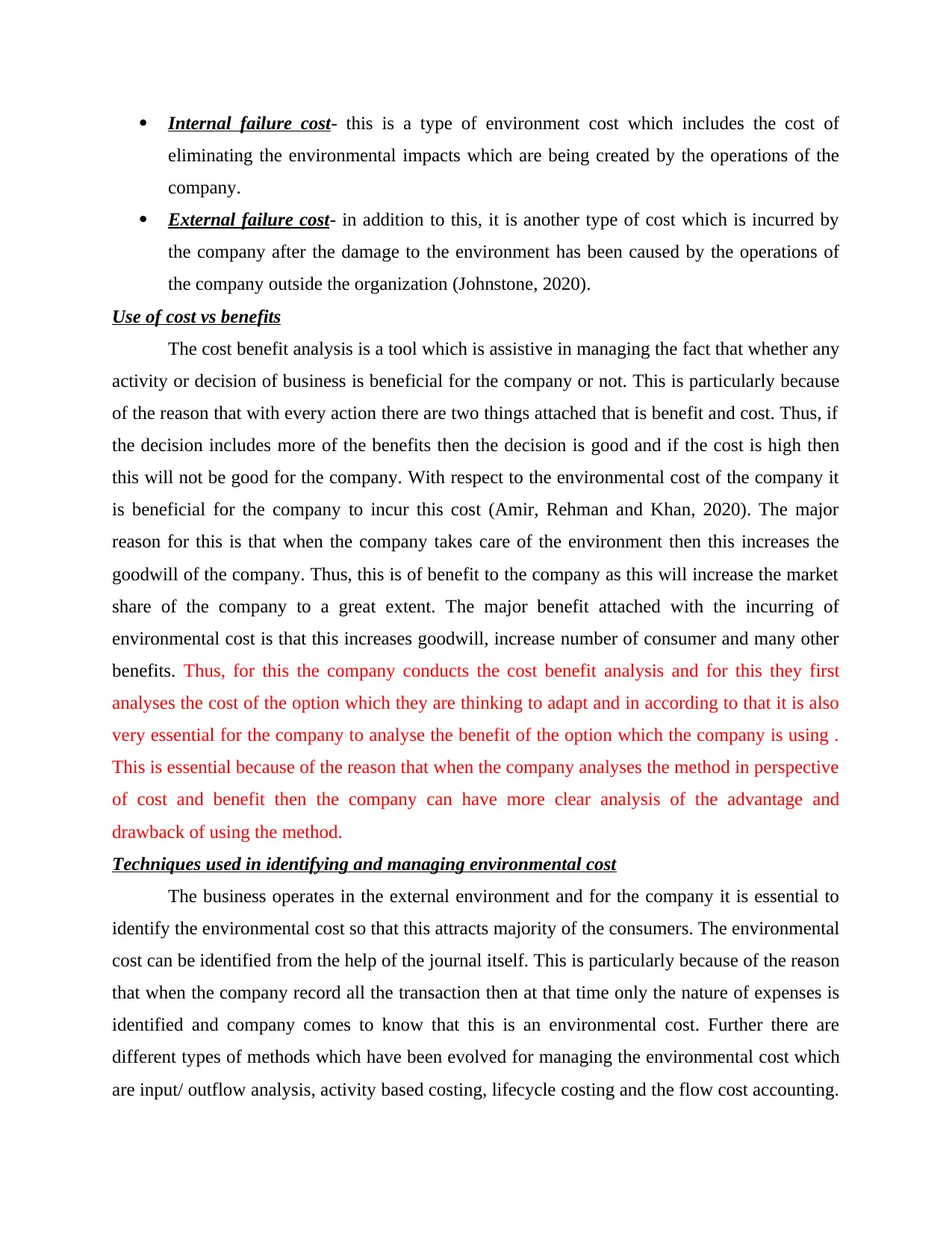
Internal failure cost- this is a type of environment cost which includes the cost of
eliminating the environmental impacts which are being created by the operations of the
company.
External failure cost- in addition to this, it is another type of cost which is incurred by
the company after the damage to the environment has been caused by the operations of
the company outside the organization (Johnstone, 2020).
Use of cost vs benefits
The cost benefit analysis is a tool which is assistive in managing the fact that whether any
activity or decision of business is beneficial for the company or not. This is particularly because
of the reason that with every action there are two things attached that is benefit and cost. Thus, if
the decision includes more of the benefits then the decision is good and if the cost is high then
this will not be good for the company. With respect to the environmental cost of the company it
is beneficial for the company to incur this cost (Amir, Rehman and Khan, 2020). The major
reason for this is that when the company takes care of the environment then this increases the
goodwill of the company. Thus, this is of benefit to the company as this will increase the market
share of the company to a great extent. The major benefit attached with the incurring of
environmental cost is that this increases goodwill, increase number of consumer and many other
benefits. Thus, for this the company conducts the cost benefit analysis and for this they first
analyses the cost of the option which they are thinking to adapt and in according to that it is also
very essential for the company to analyse the benefit of the option which the company is using .
This is essential because of the reason that when the company analyses the method in perspective
of cost and benefit then the company can have more clear analysis of the advantage and
drawback of using the method.
Techniques used in identifying and managing environmental cost
The business operates in the external environment and for the company it is essential to
identify the environmental cost so that this attracts majority of the consumers. The environmental
cost can be identified from the help of the journal itself. This is particularly because of the reason
that when the company record all the transaction then at that time only the nature of expenses is
identified and company comes to know that this is an environmental cost. Further there are
different types of methods which have been evolved for managing the environmental cost which
are input/ outflow analysis, activity based costing, lifecycle costing and the flow cost accounting.
eliminating the environmental impacts which are being created by the operations of the
company.
External failure cost- in addition to this, it is another type of cost which is incurred by
the company after the damage to the environment has been caused by the operations of
the company outside the organization (Johnstone, 2020).
Use of cost vs benefits
The cost benefit analysis is a tool which is assistive in managing the fact that whether any
activity or decision of business is beneficial for the company or not. This is particularly because
of the reason that with every action there are two things attached that is benefit and cost. Thus, if
the decision includes more of the benefits then the decision is good and if the cost is high then
this will not be good for the company. With respect to the environmental cost of the company it
is beneficial for the company to incur this cost (Amir, Rehman and Khan, 2020). The major
reason for this is that when the company takes care of the environment then this increases the
goodwill of the company. Thus, this is of benefit to the company as this will increase the market
share of the company to a great extent. The major benefit attached with the incurring of
environmental cost is that this increases goodwill, increase number of consumer and many other
benefits. Thus, for this the company conducts the cost benefit analysis and for this they first
analyses the cost of the option which they are thinking to adapt and in according to that it is also
very essential for the company to analyse the benefit of the option which the company is using .
This is essential because of the reason that when the company analyses the method in perspective
of cost and benefit then the company can have more clear analysis of the advantage and
drawback of using the method.
Techniques used in identifying and managing environmental cost
The business operates in the external environment and for the company it is essential to
identify the environmental cost so that this attracts majority of the consumers. The environmental
cost can be identified from the help of the journal itself. This is particularly because of the reason
that when the company record all the transaction then at that time only the nature of expenses is
identified and company comes to know that this is an environmental cost. Further there are
different types of methods which have been evolved for managing the environmental cost which
are input/ outflow analysis, activity based costing, lifecycle costing and the flow cost accounting.
Paraphrase This Document
Need a fresh take? Get an instant paraphrase of this document with our AI Paraphraser
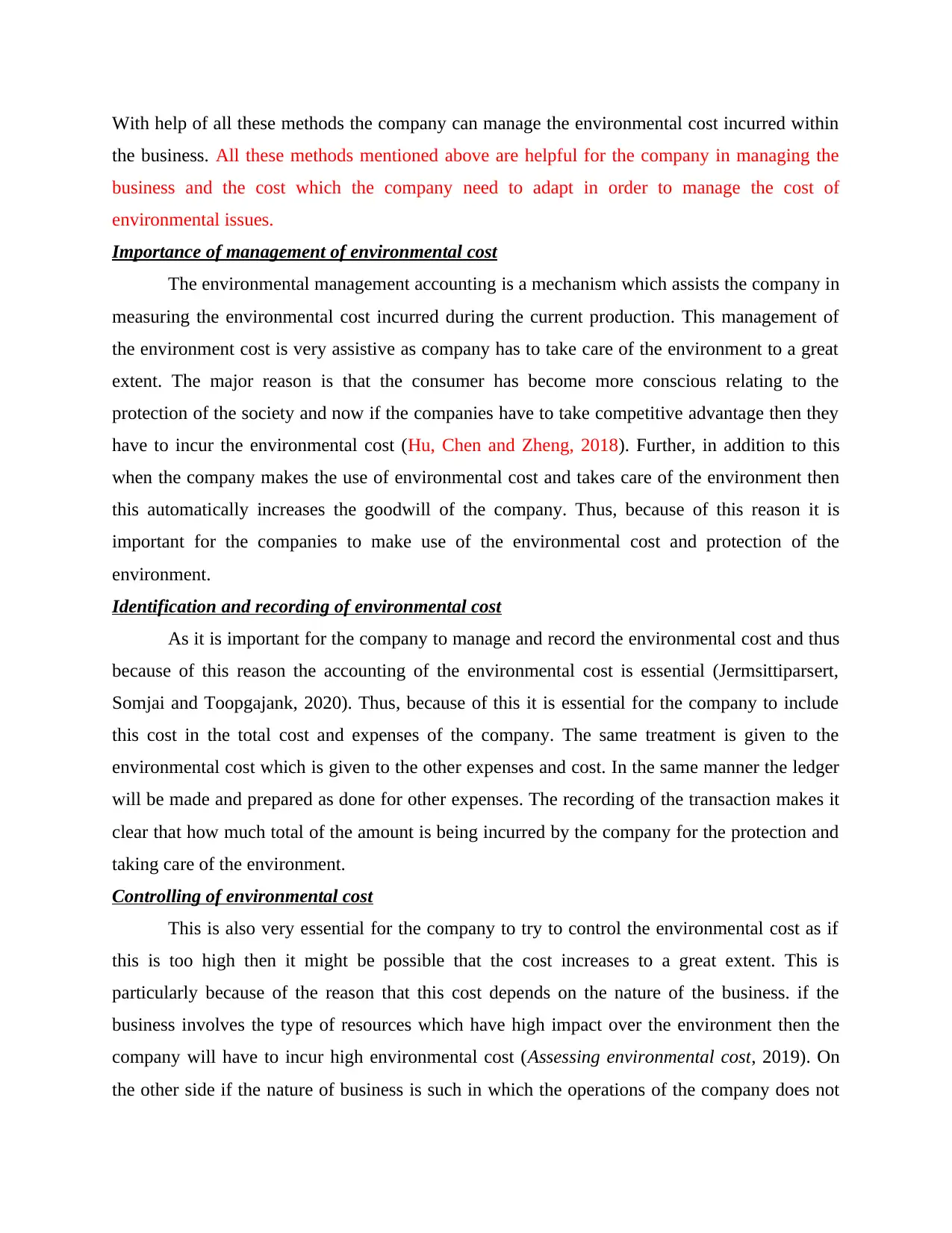
With help of all these methods the company can manage the environmental cost incurred within
the business. All these methods mentioned above are helpful for the company in managing the
business and the cost which the company need to adapt in order to manage the cost of
environmental issues.
Importance of management of environmental cost
The environmental management accounting is a mechanism which assists the company in
measuring the environmental cost incurred during the current production. This management of
the environment cost is very assistive as company has to take care of the environment to a great
extent. The major reason is that the consumer has become more conscious relating to the
protection of the society and now if the companies have to take competitive advantage then they
have to incur the environmental cost (Hu, Chen and Zheng, 2018). Further, in addition to this
when the company makes the use of environmental cost and takes care of the environment then
this automatically increases the goodwill of the company. Thus, because of this reason it is
important for the companies to make use of the environmental cost and protection of the
environment.
Identification and recording of environmental cost
As it is important for the company to manage and record the environmental cost and thus
because of this reason the accounting of the environmental cost is essential (Jermsittiparsert,
Somjai and Toopgajank, 2020). Thus, because of this it is essential for the company to include
this cost in the total cost and expenses of the company. The same treatment is given to the
environmental cost which is given to the other expenses and cost. In the same manner the ledger
will be made and prepared as done for other expenses. The recording of the transaction makes it
clear that how much total of the amount is being incurred by the company for the protection and
taking care of the environment.
Controlling of environmental cost
This is also very essential for the company to try to control the environmental cost as if
this is too high then it might be possible that the cost increases to a great extent. This is
particularly because of the reason that this cost depends on the nature of the business. if the
business involves the type of resources which have high impact over the environment then the
company will have to incur high environmental cost (Assessing environmental cost, 2019). On
the other side if the nature of business is such in which the operations of the company does not
the business. All these methods mentioned above are helpful for the company in managing the
business and the cost which the company need to adapt in order to manage the cost of
environmental issues.
Importance of management of environmental cost
The environmental management accounting is a mechanism which assists the company in
measuring the environmental cost incurred during the current production. This management of
the environment cost is very assistive as company has to take care of the environment to a great
extent. The major reason is that the consumer has become more conscious relating to the
protection of the society and now if the companies have to take competitive advantage then they
have to incur the environmental cost (Hu, Chen and Zheng, 2018). Further, in addition to this
when the company makes the use of environmental cost and takes care of the environment then
this automatically increases the goodwill of the company. Thus, because of this reason it is
important for the companies to make use of the environmental cost and protection of the
environment.
Identification and recording of environmental cost
As it is important for the company to manage and record the environmental cost and thus
because of this reason the accounting of the environmental cost is essential (Jermsittiparsert,
Somjai and Toopgajank, 2020). Thus, because of this it is essential for the company to include
this cost in the total cost and expenses of the company. The same treatment is given to the
environmental cost which is given to the other expenses and cost. In the same manner the ledger
will be made and prepared as done for other expenses. The recording of the transaction makes it
clear that how much total of the amount is being incurred by the company for the protection and
taking care of the environment.
Controlling of environmental cost
This is also very essential for the company to try to control the environmental cost as if
this is too high then it might be possible that the cost increases to a great extent. This is
particularly because of the reason that this cost depends on the nature of the business. if the
business involves the type of resources which have high impact over the environment then the
company will have to incur high environmental cost (Assessing environmental cost, 2019). On
the other side if the nature of business is such in which the operations of the company does not
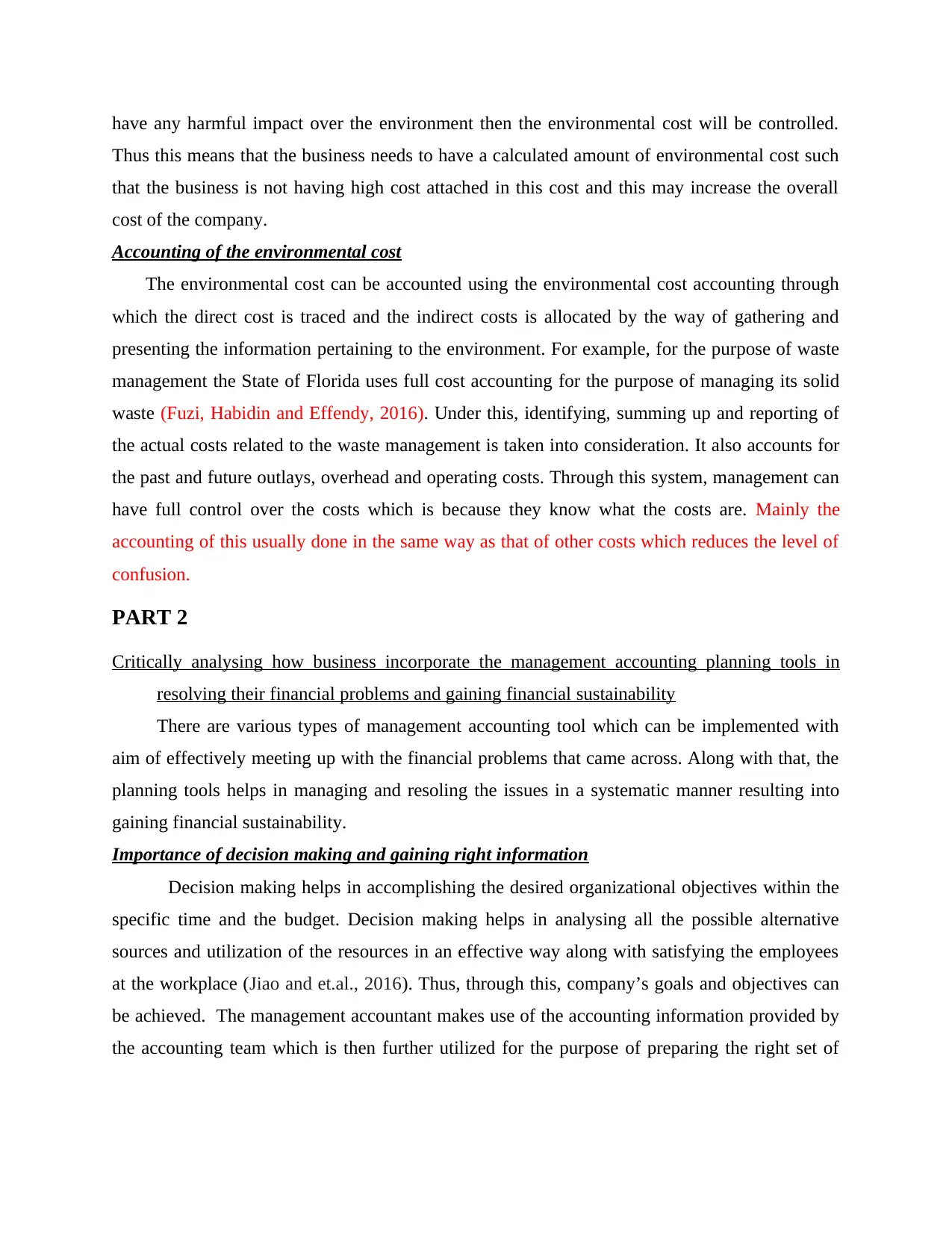
have any harmful impact over the environment then the environmental cost will be controlled.
Thus this means that the business needs to have a calculated amount of environmental cost such
that the business is not having high cost attached in this cost and this may increase the overall
cost of the company.
Accounting of the environmental cost
The environmental cost can be accounted using the environmental cost accounting through
which the direct cost is traced and the indirect costs is allocated by the way of gathering and
presenting the information pertaining to the environment. For example, for the purpose of waste
management the State of Florida uses full cost accounting for the purpose of managing its solid
waste (Fuzi, Habidin and Effendy, 2016). Under this, identifying, summing up and reporting of
the actual costs related to the waste management is taken into consideration. It also accounts for
the past and future outlays, overhead and operating costs. Through this system, management can
have full control over the costs which is because they know what the costs are. Mainly the
accounting of this usually done in the same way as that of other costs which reduces the level of
confusion.
PART 2
Critically analysing how business incorporate the management accounting planning tools in
resolving their financial problems and gaining financial sustainability
There are various types of management accounting tool which can be implemented with
aim of effectively meeting up with the financial problems that came across. Along with that, the
planning tools helps in managing and resoling the issues in a systematic manner resulting into
gaining financial sustainability.
Importance of decision making and gaining right information
Decision making helps in accomplishing the desired organizational objectives within the
specific time and the budget. Decision making helps in analysing all the possible alternative
sources and utilization of the resources in an effective way along with satisfying the employees
at the workplace (Jiao and et.al., 2016). Thus, through this, company’s goals and objectives can
be achieved. The management accountant makes use of the accounting information provided by
the accounting team which is then further utilized for the purpose of preparing the right set of
Thus this means that the business needs to have a calculated amount of environmental cost such
that the business is not having high cost attached in this cost and this may increase the overall
cost of the company.
Accounting of the environmental cost
The environmental cost can be accounted using the environmental cost accounting through
which the direct cost is traced and the indirect costs is allocated by the way of gathering and
presenting the information pertaining to the environment. For example, for the purpose of waste
management the State of Florida uses full cost accounting for the purpose of managing its solid
waste (Fuzi, Habidin and Effendy, 2016). Under this, identifying, summing up and reporting of
the actual costs related to the waste management is taken into consideration. It also accounts for
the past and future outlays, overhead and operating costs. Through this system, management can
have full control over the costs which is because they know what the costs are. Mainly the
accounting of this usually done in the same way as that of other costs which reduces the level of
confusion.
PART 2
Critically analysing how business incorporate the management accounting planning tools in
resolving their financial problems and gaining financial sustainability
There are various types of management accounting tool which can be implemented with
aim of effectively meeting up with the financial problems that came across. Along with that, the
planning tools helps in managing and resoling the issues in a systematic manner resulting into
gaining financial sustainability.
Importance of decision making and gaining right information
Decision making helps in accomplishing the desired organizational objectives within the
specific time and the budget. Decision making helps in analysing all the possible alternative
sources and utilization of the resources in an effective way along with satisfying the employees
at the workplace (Jiao and et.al., 2016). Thus, through this, company’s goals and objectives can
be achieved. The management accountant makes use of the accounting information provided by
the accounting team which is then further utilized for the purpose of preparing the right set of
⊘ This is a preview!⊘
Do you want full access?
Subscribe today to unlock all pages.

Trusted by 1+ million students worldwide
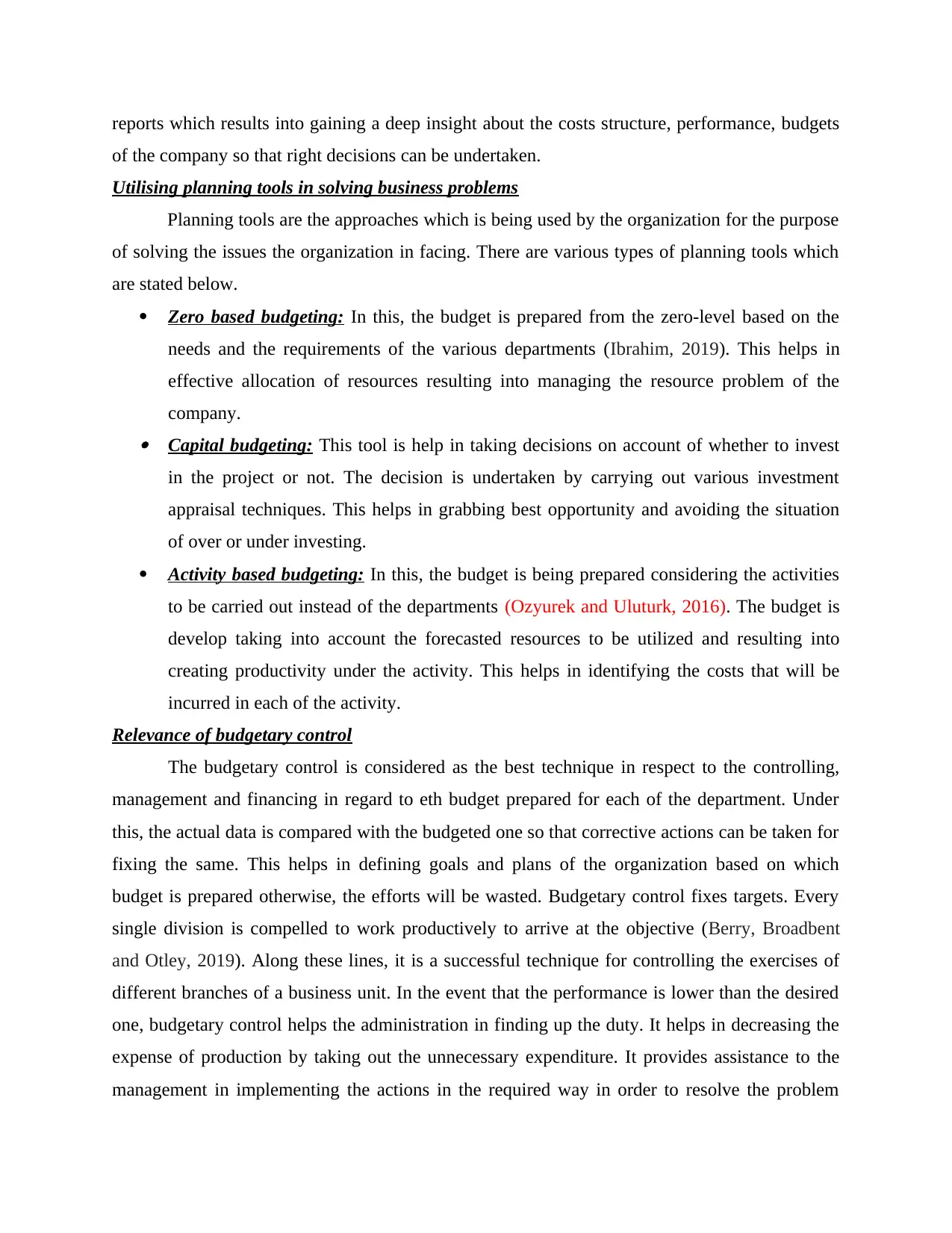
reports which results into gaining a deep insight about the costs structure, performance, budgets
of the company so that right decisions can be undertaken.
Utilising planning tools in solving business problems
Planning tools are the approaches which is being used by the organization for the purpose
of solving the issues the organization in facing. There are various types of planning tools which
are stated below.
Zero based budgeting: In this, the budget is prepared from the zero-level based on the
needs and the requirements of the various departments (Ibrahim, 2019). This helps in
effective allocation of resources resulting into managing the resource problem of the
company. Capital budgeting: This tool is help in taking decisions on account of whether to invest
in the project or not. The decision is undertaken by carrying out various investment
appraisal techniques. This helps in grabbing best opportunity and avoiding the situation
of over or under investing.
Activity based budgeting: In this, the budget is being prepared considering the activities
to be carried out instead of the departments (Ozyurek and Uluturk, 2016). The budget is
develop taking into account the forecasted resources to be utilized and resulting into
creating productivity under the activity. This helps in identifying the costs that will be
incurred in each of the activity.
Relevance of budgetary control
The budgetary control is considered as the best technique in respect to the controlling,
management and financing in regard to eth budget prepared for each of the department. Under
this, the actual data is compared with the budgeted one so that corrective actions can be taken for
fixing the same. This helps in defining goals and plans of the organization based on which
budget is prepared otherwise, the efforts will be wasted. Budgetary control fixes targets. Every
single division is compelled to work productively to arrive at the objective (Berry, Broadbent
and Otley, 2019). Along these lines, it is a successful technique for controlling the exercises of
different branches of a business unit. In the event that the performance is lower than the desired
one, budgetary control helps the administration in finding up the duty. It helps in decreasing the
expense of production by taking out the unnecessary expenditure. It provides assistance to the
management in implementing the actions in the required way in order to resolve the problem
of the company so that right decisions can be undertaken.
Utilising planning tools in solving business problems
Planning tools are the approaches which is being used by the organization for the purpose
of solving the issues the organization in facing. There are various types of planning tools which
are stated below.
Zero based budgeting: In this, the budget is prepared from the zero-level based on the
needs and the requirements of the various departments (Ibrahim, 2019). This helps in
effective allocation of resources resulting into managing the resource problem of the
company. Capital budgeting: This tool is help in taking decisions on account of whether to invest
in the project or not. The decision is undertaken by carrying out various investment
appraisal techniques. This helps in grabbing best opportunity and avoiding the situation
of over or under investing.
Activity based budgeting: In this, the budget is being prepared considering the activities
to be carried out instead of the departments (Ozyurek and Uluturk, 2016). The budget is
develop taking into account the forecasted resources to be utilized and resulting into
creating productivity under the activity. This helps in identifying the costs that will be
incurred in each of the activity.
Relevance of budgetary control
The budgetary control is considered as the best technique in respect to the controlling,
management and financing in regard to eth budget prepared for each of the department. Under
this, the actual data is compared with the budgeted one so that corrective actions can be taken for
fixing the same. This helps in defining goals and plans of the organization based on which
budget is prepared otherwise, the efforts will be wasted. Budgetary control fixes targets. Every
single division is compelled to work productively to arrive at the objective (Berry, Broadbent
and Otley, 2019). Along these lines, it is a successful technique for controlling the exercises of
different branches of a business unit. In the event that the performance is lower than the desired
one, budgetary control helps the administration in finding up the duty. It helps in decreasing the
expense of production by taking out the unnecessary expenditure. It provides assistance to the
management in implementing the actions in the required way in order to resolve the problem
Paraphrase This Document
Need a fresh take? Get an instant paraphrase of this document with our AI Paraphraser
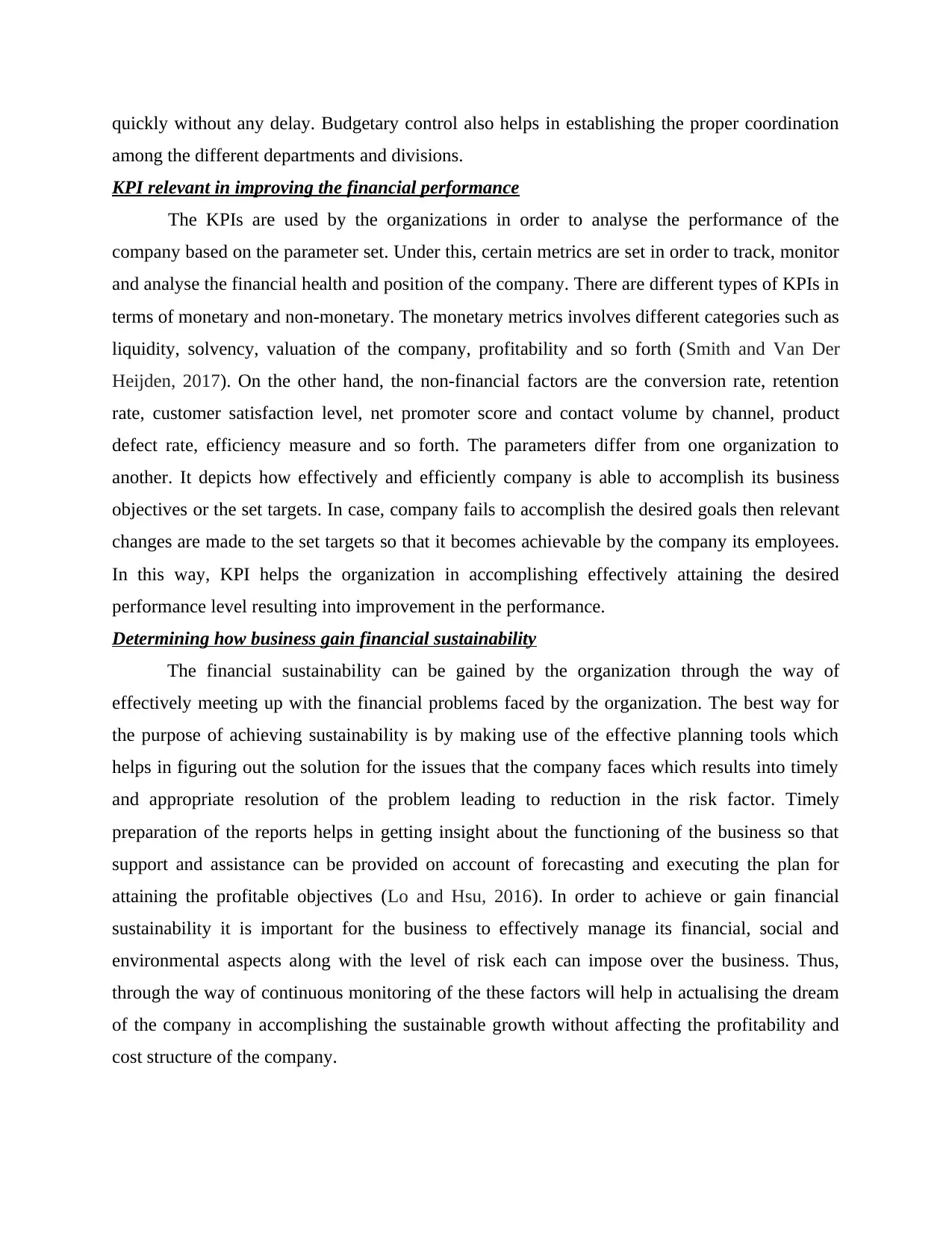
quickly without any delay. Budgetary control also helps in establishing the proper coordination
among the different departments and divisions.
KPI relevant in improving the financial performance
The KPIs are used by the organizations in order to analyse the performance of the
company based on the parameter set. Under this, certain metrics are set in order to track, monitor
and analyse the financial health and position of the company. There are different types of KPIs in
terms of monetary and non-monetary. The monetary metrics involves different categories such as
liquidity, solvency, valuation of the company, profitability and so forth (Smith and Van Der
Heijden, 2017). On the other hand, the non-financial factors are the conversion rate, retention
rate, customer satisfaction level, net promoter score and contact volume by channel, product
defect rate, efficiency measure and so forth. The parameters differ from one organization to
another. It depicts how effectively and efficiently company is able to accomplish its business
objectives or the set targets. In case, company fails to accomplish the desired goals then relevant
changes are made to the set targets so that it becomes achievable by the company its employees.
In this way, KPI helps the organization in accomplishing effectively attaining the desired
performance level resulting into improvement in the performance.
Determining how business gain financial sustainability
The financial sustainability can be gained by the organization through the way of
effectively meeting up with the financial problems faced by the organization. The best way for
the purpose of achieving sustainability is by making use of the effective planning tools which
helps in figuring out the solution for the issues that the company faces which results into timely
and appropriate resolution of the problem leading to reduction in the risk factor. Timely
preparation of the reports helps in getting insight about the functioning of the business so that
support and assistance can be provided on account of forecasting and executing the plan for
attaining the profitable objectives (Lo and Hsu, 2016). In order to achieve or gain financial
sustainability it is important for the business to effectively manage its financial, social and
environmental aspects along with the level of risk each can impose over the business. Thus,
through the way of continuous monitoring of the these factors will help in actualising the dream
of the company in accomplishing the sustainable growth without affecting the profitability and
cost structure of the company.
among the different departments and divisions.
KPI relevant in improving the financial performance
The KPIs are used by the organizations in order to analyse the performance of the
company based on the parameter set. Under this, certain metrics are set in order to track, monitor
and analyse the financial health and position of the company. There are different types of KPIs in
terms of monetary and non-monetary. The monetary metrics involves different categories such as
liquidity, solvency, valuation of the company, profitability and so forth (Smith and Van Der
Heijden, 2017). On the other hand, the non-financial factors are the conversion rate, retention
rate, customer satisfaction level, net promoter score and contact volume by channel, product
defect rate, efficiency measure and so forth. The parameters differ from one organization to
another. It depicts how effectively and efficiently company is able to accomplish its business
objectives or the set targets. In case, company fails to accomplish the desired goals then relevant
changes are made to the set targets so that it becomes achievable by the company its employees.
In this way, KPI helps the organization in accomplishing effectively attaining the desired
performance level resulting into improvement in the performance.
Determining how business gain financial sustainability
The financial sustainability can be gained by the organization through the way of
effectively meeting up with the financial problems faced by the organization. The best way for
the purpose of achieving sustainability is by making use of the effective planning tools which
helps in figuring out the solution for the issues that the company faces which results into timely
and appropriate resolution of the problem leading to reduction in the risk factor. Timely
preparation of the reports helps in getting insight about the functioning of the business so that
support and assistance can be provided on account of forecasting and executing the plan for
attaining the profitable objectives (Lo and Hsu, 2016). In order to achieve or gain financial
sustainability it is important for the business to effectively manage its financial, social and
environmental aspects along with the level of risk each can impose over the business. Thus,
through the way of continuous monitoring of the these factors will help in actualising the dream
of the company in accomplishing the sustainable growth without affecting the profitability and
cost structure of the company.
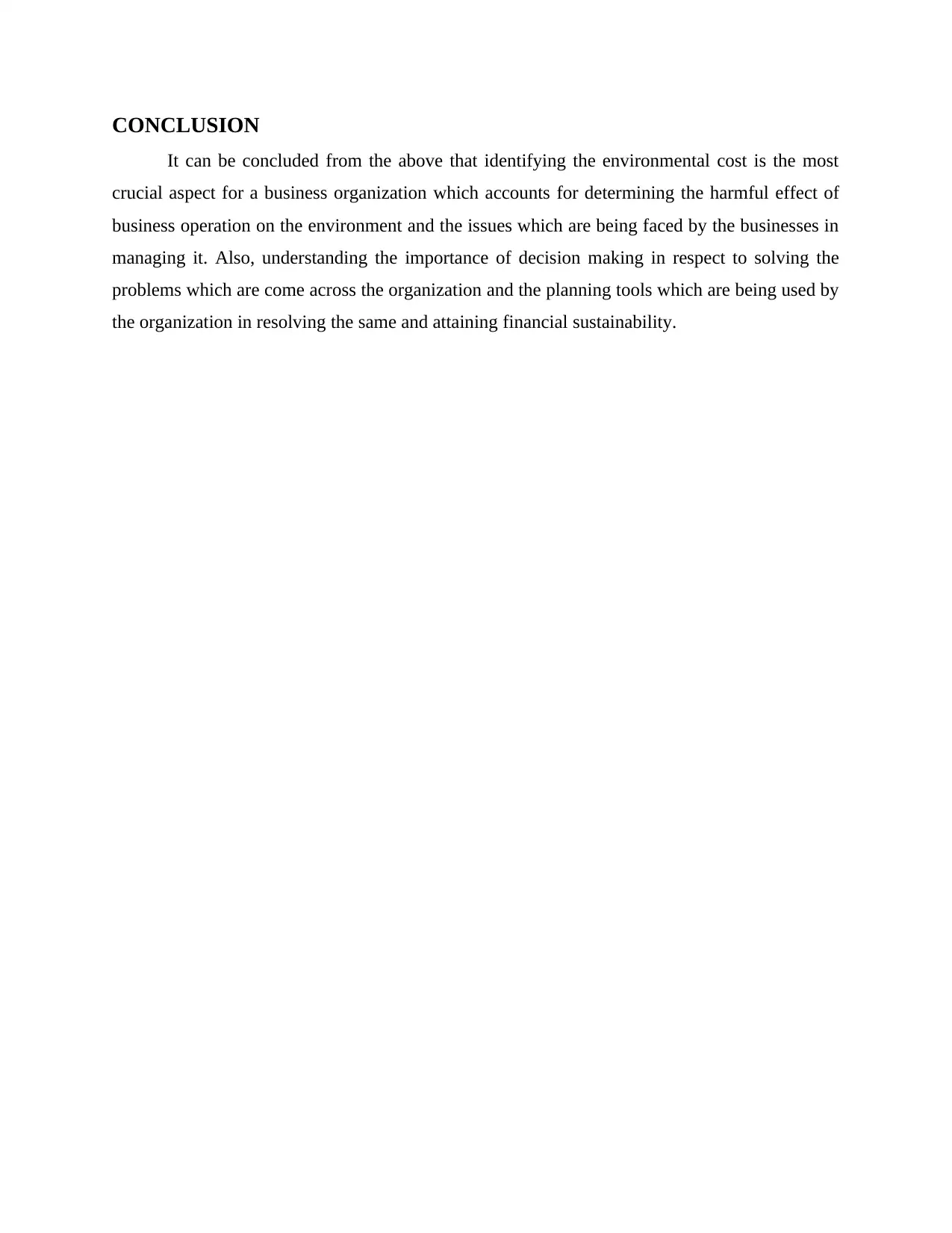
CONCLUSION
It can be concluded from the above that identifying the environmental cost is the most
crucial aspect for a business organization which accounts for determining the harmful effect of
business operation on the environment and the issues which are being faced by the businesses in
managing it. Also, understanding the importance of decision making in respect to solving the
problems which are come across the organization and the planning tools which are being used by
the organization in resolving the same and attaining financial sustainability.
It can be concluded from the above that identifying the environmental cost is the most
crucial aspect for a business organization which accounts for determining the harmful effect of
business operation on the environment and the issues which are being faced by the businesses in
managing it. Also, understanding the importance of decision making in respect to solving the
problems which are come across the organization and the planning tools which are being used by
the organization in resolving the same and attaining financial sustainability.
⊘ This is a preview!⊘
Do you want full access?
Subscribe today to unlock all pages.

Trusted by 1+ million students worldwide
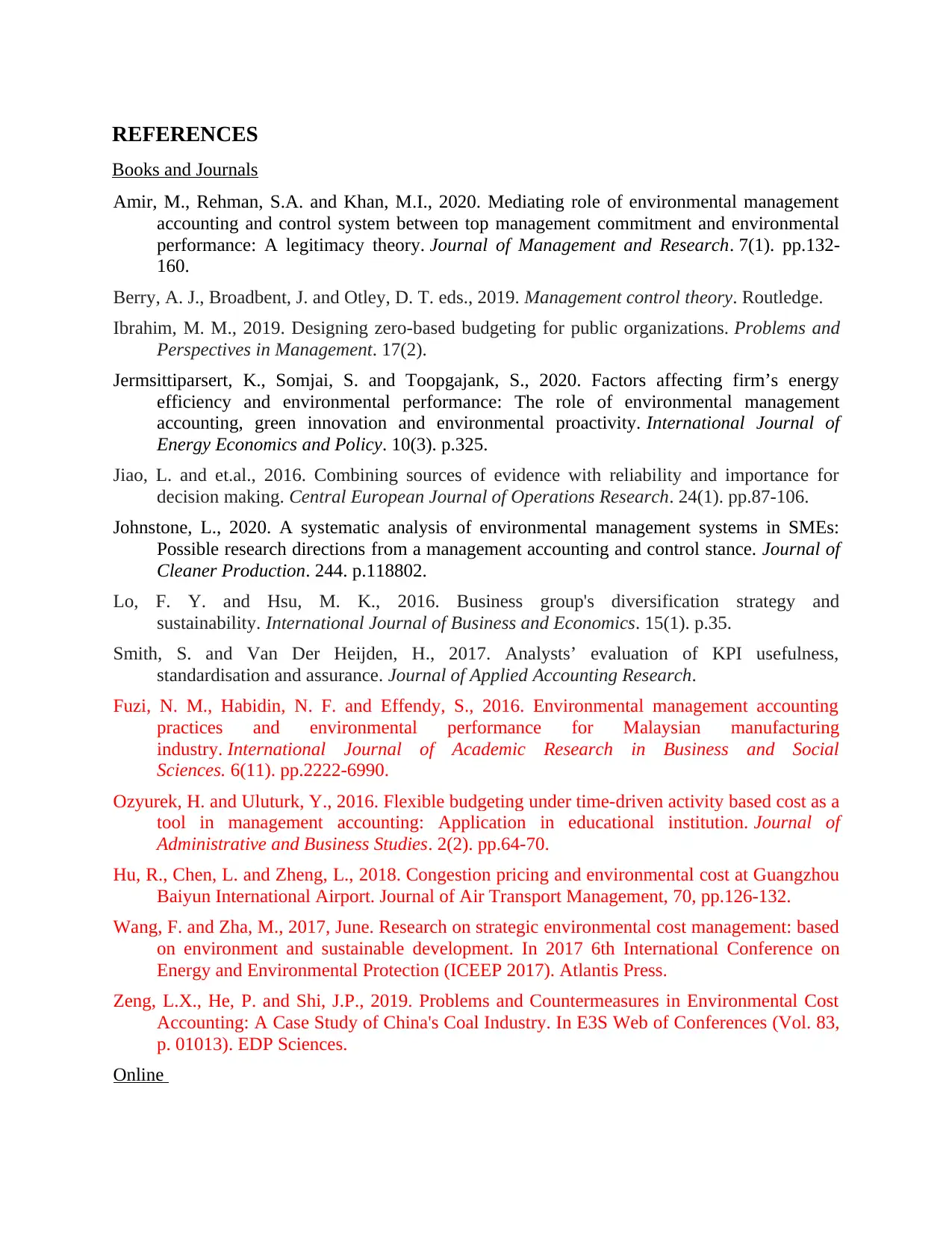
REFERENCES
Books and Journals
Amir, M., Rehman, S.A. and Khan, M.I., 2020. Mediating role of environmental management
accounting and control system between top management commitment and environmental
performance: A legitimacy theory. Journal of Management and Research. 7(1). pp.132-
160.
Berry, A. J., Broadbent, J. and Otley, D. T. eds., 2019. Management control theory. Routledge.
Ibrahim, M. M., 2019. Designing zero-based budgeting for public organizations. Problems and
Perspectives in Management. 17(2).
Jermsittiparsert, K., Somjai, S. and Toopgajank, S., 2020. Factors affecting firm’s energy
efficiency and environmental performance: The role of environmental management
accounting, green innovation and environmental proactivity. International Journal of
Energy Economics and Policy. 10(3). p.325.
Jiao, L. and et.al., 2016. Combining sources of evidence with reliability and importance for
decision making. Central European Journal of Operations Research. 24(1). pp.87-106.
Johnstone, L., 2020. A systematic analysis of environmental management systems in SMEs:
Possible research directions from a management accounting and control stance. Journal of
Cleaner Production. 244. p.118802.
Lo, F. Y. and Hsu, M. K., 2016. Business group's diversification strategy and
sustainability. International Journal of Business and Economics. 15(1). p.35.
Smith, S. and Van Der Heijden, H., 2017. Analysts’ evaluation of KPI usefulness,
standardisation and assurance. Journal of Applied Accounting Research.
Fuzi, N. M., Habidin, N. F. and Effendy, S., 2016. Environmental management accounting
practices and environmental performance for Malaysian manufacturing
industry. International Journal of Academic Research in Business and Social
Sciences. 6(11). pp.2222-6990.
Ozyurek, H. and Uluturk, Y., 2016. Flexible budgeting under time-driven activity based cost as a
tool in management accounting: Application in educational institution. Journal of
Administrative and Business Studies. 2(2). pp.64-70.
Hu, R., Chen, L. and Zheng, L., 2018. Congestion pricing and environmental cost at Guangzhou
Baiyun International Airport. Journal of Air Transport Management, 70, pp.126-132.
Wang, F. and Zha, M., 2017, June. Research on strategic environmental cost management: based
on environment and sustainable development. In 2017 6th International Conference on
Energy and Environmental Protection (ICEEP 2017). Atlantis Press.
Zeng, L.X., He, P. and Shi, J.P., 2019. Problems and Countermeasures in Environmental Cost
Accounting: A Case Study of China's Coal Industry. In E3S Web of Conferences (Vol. 83,
p. 01013). EDP Sciences.
Online
Books and Journals
Amir, M., Rehman, S.A. and Khan, M.I., 2020. Mediating role of environmental management
accounting and control system between top management commitment and environmental
performance: A legitimacy theory. Journal of Management and Research. 7(1). pp.132-
160.
Berry, A. J., Broadbent, J. and Otley, D. T. eds., 2019. Management control theory. Routledge.
Ibrahim, M. M., 2019. Designing zero-based budgeting for public organizations. Problems and
Perspectives in Management. 17(2).
Jermsittiparsert, K., Somjai, S. and Toopgajank, S., 2020. Factors affecting firm’s energy
efficiency and environmental performance: The role of environmental management
accounting, green innovation and environmental proactivity. International Journal of
Energy Economics and Policy. 10(3). p.325.
Jiao, L. and et.al., 2016. Combining sources of evidence with reliability and importance for
decision making. Central European Journal of Operations Research. 24(1). pp.87-106.
Johnstone, L., 2020. A systematic analysis of environmental management systems in SMEs:
Possible research directions from a management accounting and control stance. Journal of
Cleaner Production. 244. p.118802.
Lo, F. Y. and Hsu, M. K., 2016. Business group's diversification strategy and
sustainability. International Journal of Business and Economics. 15(1). p.35.
Smith, S. and Van Der Heijden, H., 2017. Analysts’ evaluation of KPI usefulness,
standardisation and assurance. Journal of Applied Accounting Research.
Fuzi, N. M., Habidin, N. F. and Effendy, S., 2016. Environmental management accounting
practices and environmental performance for Malaysian manufacturing
industry. International Journal of Academic Research in Business and Social
Sciences. 6(11). pp.2222-6990.
Ozyurek, H. and Uluturk, Y., 2016. Flexible budgeting under time-driven activity based cost as a
tool in management accounting: Application in educational institution. Journal of
Administrative and Business Studies. 2(2). pp.64-70.
Hu, R., Chen, L. and Zheng, L., 2018. Congestion pricing and environmental cost at Guangzhou
Baiyun International Airport. Journal of Air Transport Management, 70, pp.126-132.
Wang, F. and Zha, M., 2017, June. Research on strategic environmental cost management: based
on environment and sustainable development. In 2017 6th International Conference on
Energy and Environmental Protection (ICEEP 2017). Atlantis Press.
Zeng, L.X., He, P. and Shi, J.P., 2019. Problems and Countermeasures in Environmental Cost
Accounting: A Case Study of China's Coal Industry. In E3S Web of Conferences (Vol. 83,
p. 01013). EDP Sciences.
Online
Paraphrase This Document
Need a fresh take? Get an instant paraphrase of this document with our AI Paraphraser

Assessing environmental cost. 2019. [Online]. Available through: <
https://www.sciencedirect.com/topics/earth-and-planetary-sciences/environmental-cost>
Environmental management accounting. 2020. [Online]. Available through: <
https://www.accaglobal.com/gb/en/student/exam-support-resources/fundamentals-exams-
study-resources/f5/technical-articles/Env-MA.html#:~:text=In%202003%2C%20the
%20UNDSD%20identified,of%20accounting%20for%20environmental%20costs'.>
https://www.sciencedirect.com/topics/earth-and-planetary-sciences/environmental-cost>
Environmental management accounting. 2020. [Online]. Available through: <
https://www.accaglobal.com/gb/en/student/exam-support-resources/fundamentals-exams-
study-resources/f5/technical-articles/Env-MA.html#:~:text=In%202003%2C%20the
%20UNDSD%20identified,of%20accounting%20for%20environmental%20costs'.>
1 out of 11
Related Documents
Your All-in-One AI-Powered Toolkit for Academic Success.
+13062052269
info@desklib.com
Available 24*7 on WhatsApp / Email
![[object Object]](/_next/static/media/star-bottom.7253800d.svg)
Unlock your academic potential
Copyright © 2020–2025 A2Z Services. All Rights Reserved. Developed and managed by ZUCOL.





